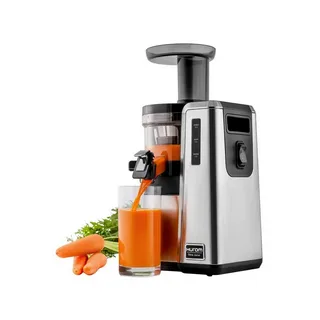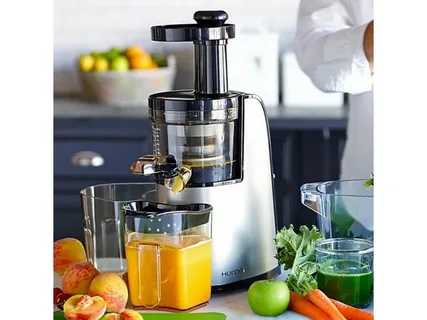Are you still using your old, traditional juicer to make homemade juice? If so, it’s time to ditch it and switch to a Slow Juicer! With a Slow-Juicer, you can quickly and easily make delicious, nutrient-rich juices without any of the mess or hassle of a traditional juicer. Plus, a Slow-Juicer is more efficient, preserving more beneficial nutrients you would otherwise lose in traditional juicing. So ditch your old juicer and switch to a Slow-Juicer today!
What is Slow Press Juicer?
Slow Press Juicer, also known as masticating or cold-press juicers, are a new and improved type of juicer that has recently gained popularity. These juicers slowly grind fruits and vegetables using a high-powered motor, yielding more than traditional centrifugal juicers.
They are called Slow-Juicers because of the slow speed at which they operate. They rotate at a slower speed than traditional juicers, reducing oxidation and heat build-up during juicing. It ultimately helps preserve the nutrients and enzymes in the fruits and vegetables, resulting in a more nutrient-rich juice.
Another critical feature of slow-press juicers is that they are incredibly versatile. They can extract juice from various fruits and vegetables, including leafy greens, root vegetables, and hard fruits. Additionally, Slow-Juicers can make nut milk and soy milk, as well as extruding pasta and making sorbets.
Overall, slow-press juicers offer many benefits over traditional centrifugal juicers. They are quieter, more efficient, and produce higher-quality juice with a longer shelf life. If you want to improve your juicing game and take your health to the next level, investing in a slow-press juicer may be the perfect choice.
 How to Use a Slow-Juicer?
How to Use a Slow-Juicer?
Using a Slow-Juicer is easy, even if you have no prior experience with juicers. The first step is ensuring the machine is assembled correctly and cleaned. Then, cut up your fruits and vegetables into pieces that can fit into the feeding chute.
Once you have your ingredients ready, turn on the machine and slowly feed the produce into the feeding chute using the included pusher tool. The slow-juicer will take care of the rest, pressing and squeezing the fruits and vegetables to extract the juice.
It’s important to note that Slow-Juicers can be more delicate than traditional juicers, so avoiding using hard or dense ingredients like ice, frozen fruits, or hard vegetables like beets or carrots is best. Instead, stick to softer fruits and leafy greens like apples, berries, kale, and spinach.
Also, Slow-Juicers often produce thicker and pulpy juice than traditional juicers, which extract more juice but with less fibre. Strain a smoother juice through a fine-mesh sieve or cheesecloth if you prefer a smoother juice.
Overall, using a Slow-Juicer is a simple and efficient way to make delicious and nutritious juices at home. With a bit of practice, you can create customized blends that support your health and wellness goals.
The Benefits of Slow Juicing
Slow juicing, also known as masticating or cold-press juicing, is a method of extracting juice from fruits and vegetables at a slower speed compared to traditional high-speed juicers. This process involves crushing and pressing the produce to extract the juice instead of using high-speed blades or centrifugal force. Slow juicing offers several benefits:
Higher Nutritional Value: Slow juicing preserves more nutrients and enzymes than high-speed juicers. The gentle extraction process minimizes heat and oxidation, which can degrade the nutrients in the juice. As a result, slow juicing retains more vitamins, minerals, and antioxidants, providing you with a nutrient-dense beverage.
Better Taste and Texture: Slow-Juicers produce juice with a richer taste and smoother texture. The slow extraction process maintains the natural flavours of the fruits and vegetables, resulting in a more pronounced and enjoyable taste experience. The juice also tends to be less frothy and pulpy, offering a smoother mouthfeel.
Increased Juice Yield: Slow-Juicers are highly efficient in extracting juice from produce. They extract more juice and leave behind drier pulp, ensuring you get the maximum yield from your ingredients. It can be particularly advantageous when using expensive or hard-to-find ingredients, as Slow-Juicers help you get the most out of them.
Longer Shelf Life: Due to the reduced oxidation and minimal exposure to heat, slow-pressed juices have a longer shelf life than juices extracted using high-speed methods. The slower extraction process helps to preserve the freshness and quality of the juice, allowing you to store it for a longer duration without significant degradation.
Less Foam and Separation: Slow-Juicers produce juice with minimal foam and separation. The low-speed extraction process minimizes air incorporation, resulting in less froth in the juice. Additionally, the juice tends to have a more consistent texture, with fewer layers or separation over time, making it visually appealing and easier to drink.
Versatility: Slow-Juicers can handle various produce, including leafy greens, wheatgrass, and herbs. Their slow and powerful extraction process ensures efficient juicing of soft and hard ingredients, expanding your options for creating nutrient-rich blends.
Quieter Operation: Compared to high-speed juicers that can be noisy, Slow-Juicers operate at a lower speed, resulting in a quieter juicing experience. It can be particularly beneficial if you prefer a calm and peaceful environment while preparing your juice.
Retaining Nutrients: Slow-Juicer vs. Traditional Juicer
Retaining the maximum amount of nutrients is critical when it comes to juicing. While traditional centrifugal juicers have been a popular choice for years, there may be better options for those looking to get the most out of their juice.
Slow or masticating juicers use a slow and gentle squeezing action to extract juice from fruits and vegetables. This method preserves more nutrients, vitamins, and minerals in the juice. Traditional juicers, on the other hand, use a high-speed spinning blade to extract juice quickly. It can result in more heat, friction, and oxidation, destroying some nutrients.
A study by the University of Bonn found that Slow-Juicers produced juice with a higher vitamin and mineral content than traditional juicers. The study showed that Slow-Juicers retained up to 50% more vitamin C and 60% more vitamin A in the juice.
Aside from preserving nutrients, Slow-Juicers also produce less heat, noise, and foam than traditional juicers. It means you can enjoy a more flavorful and smoother juice that’s quieter and less messy.
In summary, Slow-Juicers offer a significant advantage over traditional juicers when retaining nutrients in the juice. So, if you want to get the most out of your fruits and vegetables, it’s time to ditch your old juicer and switch to a slow one. Your taste buds and your body will thank you.
The Importance of Slow Juicing for a Healthy Lifestyle
Slow juicing is an essential element of a healthy lifestyle. It provides a great way to get your daily dose of fruits and vegetables and ensures that you are consuming them in their purest and most nutrient-dense form. Unlike traditional juicers that heat the fruits and vegetables during juicing, Slow-Juicers operate at low speeds and extract juice without any heat. This slow and gentle extraction process preserves all fruits and vegetables vitamins, minerals, and enzymes.
The nutrients in fruits and vegetables are vital for maintaining a healthy body and preventing disease. Slow juicing provides an easy way to increase your daily intake of these essential nutrients. Research shows that individuals who regularly consume fresh juice have higher levels of antioxidants and micronutrients in their bodies. These antioxidants help to combat free radicals and protect against cellular damage, which can lead to chronic disease.
Another benefit of slow juicing is the increased absorption of nutrients. When you consume a smoothie or juice, your body can easily digest and absorb the nutrients due to the breakdown of the cell walls during the juicing process. It means you can get more nutrients from a glass of juice than you would from eating whole fruits and vegetables.
In addition to the nutritional benefits, slow juicing also promotes a healthier lifestyle by encouraging a more balanced diet. Incorporating fresh juice into your daily routine makes you more likely to make healthier choices throughout the day. It can also help curb cravings for unhealthy snacks, as the juice’s nutrients help satisfy hunger and provide sustained energy.
How to Choose the Right Juice Extractor?
When choosing a Juice Extractor, several factors must be considered to ensure you select the right one for your needs. Here are some key considerations:
Types of Juice-Extractors: There are generally two main types of juice-extractors: centrifugal and masticating. Centrifugal juicers work by shredding fruits and vegetables with a fast-spinning blade, while masticating (also known as cold press or Slow-Juicers) use a drill to crush and squeeze the juice out. Masticating juicers are typically slower but can produce higher-quality juice with more nutrients. Consider which type aligns with your preferences and requirements.
Juicing Efficiency: Look for a juice-extractor that efficiently extracts juice from various fruits and vegetables. Some models may have better extraction capabilities, yielding more juice and drier pulp.
Speed Settings: Centrifugal juicers often have multiple speed settings, allowing you to adjust the speed based on the type of produce being juiced. This flexibility can help optimize the extraction process for different fruits and vegetables.
Noise Level: Centrifugal juicers tend to be louder due to their high-speed operation, while masticating juicers operate slower and produce less noise. Consider a masticating juicer or a centrifugal model with noise-reduction features if noise concerns you.
Cleaning and Maintenance: Juicers can be challenging to clean, so consider easily disassembled models with dishwasher-safe parts. Some juicers come with cleaning brushes designed to remove pulp from hard-to-reach areas.
Size and Design: Consider the available space in your kitchen and choose a juicer with a size and design that fits your needs. A compact or aesthetically pleasing design might be preferable if you plan to keep it on the countertop.
Durability and Warranty: Check customer reviews and ratings to assess the durability of the juicer you’re considering. Additionally, verify the warranty terms to ensure you’re covered in case of any defects or malfunctions.
Budget: Set a budget range for your juicer purchase. Juicers come in a wide price range, so it’s essential to find one that meets your requirements and is within your budget.
Additional Features: Some juicers offer extra features like citrus press attachments or pulp control settings. Consider whether these other features align with your juicing preferences.
Conclusion
In conclusion, switching to a Slow-Juicer is a smart choice if you are looking for a healthier lifestyle. With a Slow-Juicer, you will retain the nutrients of your fruits and vegetables and have a tastier juice with less foam.
| Other Good Articles to Read |
| niche blogs connect |
| blogs 97 |
| blog stitution |
| blogs unplugged |
| blogs cotchrouge |
| blog signatr |
| blog sintonias |
| blog zilla |
| consumer forums |
| finance forums |
| g blogs |
| too blog |



